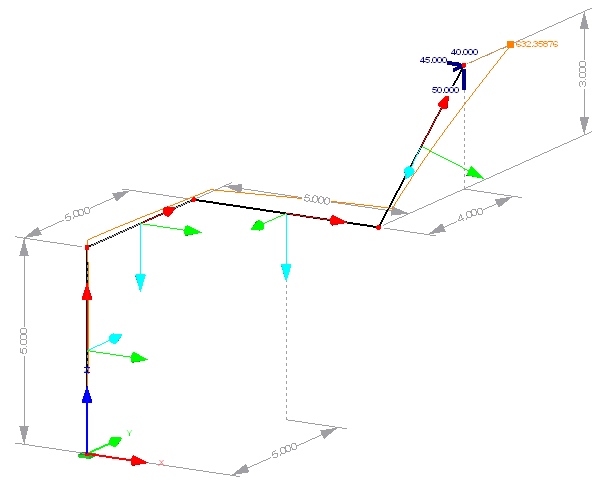Users:General FEM Analysis/Elements Reference/BeamNL
Contents |
General Description
Element Type
- This beam element is a 2 node non-linear 3D-beam for large rotations and small deformations (Green-Lagrange-strains) taking into account shear deformation (Timoshenko-beam element).
- This beam element has 6 DOFs per node (three translations and three rotations).
- The stiffness matrix is obtained using a one-point Gaussian quadrature, which results in an under-integration of the shear terms. This should prevent shear-locking.
Degrees of Freedom
For the BeamNL element use the 3 translatoric degrees of freedom DISP_X, DISP_Y, DISP_Z and the 3 rotatoric degrees of freedom ROT_X, ROT_Y, ROT_Z.
Orientation of the local coordinate system
The Beam1 element uses the following definition for the determination of the local coordinate system (needed for the orientation of IYY and IZZ,...):
- the local x-axis is oriented from node 1 to node 2 of the beam
- the local y-axis lies in the global XY-plane, such that the local z-axis points in the same half-space as the global Z-axis (mathematically spoken: the local z-axis and the global Z-axis result in a positive dot-product)
- the local z-axis is perpendicular to the other two local axis, following the right-hand-rule for x-y-z
- exception: If the local x-axis (i.e. the beam axis) points in the direction of global Z, the local y-axis points in the direction of the global Z-axis. The local z-axis once again follows the right-hand-rule for x-y-z.
In case that a rotation of the local coordinate system is needed (rotated elements, inverse definition of IYY and IZZ,...) an angle THETA has to be specified. This angle rotates the whole coordinate system around the local x-axis, following the right-thumb rule (i.e. the thumb of the right hand points in the direction of the local x-axis).
Input Parameters
Parameter Description
| Compulsory Parameters | ||
| Parameter | Values, Default(*) | Description |
|---|---|---|
| MAT | EL-MAT int | Number for the used Material
e.g. MAT=EL-MAT 1 |
| AREA | Definition of the cross-sectional area of the beam | |
| SHEAR_SECTION_Y, SHEAR_SECTION_Z | Definition of the shear-cross-sectional area of the beam in y- and z-direction | |
| IYY, IZZ | Definition of the moments of inertia | |
| Optional Parameters | ||
| KY, KZ | 0 | Shear correction factor; if 0 or no value specified, shear is not taken into account (Bernouolli-beam theory) |
| THETA | 0 | Angle of rotation of the local coordinate system around the beam axis in degrees |
Example of a Complete Input Block
EL-PROP 1 : BEAM1 MAT= EL-MAT 1 AREA=5.555 IYY=1.222 IZZ=1.333 KY=1.4 KZ=1.5 THETA=90
Use of the shear correction factors KY and KZ
The shear correction factors KY and KZ depend on the cross section of the beam. For a rectangle, KY resp. KZ are equal to 1.2, which gives a factor of α=1/Ki=5/6.
Use of the rotation parameter THETA
The rotation parameter THETA and its use is explained in the section concerning the coordinate system above.
The torsional resistance IT
The torsional resistance IT is interpreted as the polar moment Ipp, i.e.: IT = Ipp = IYY + IZZ.
Element Loading
For the moment, only nodal forces in the three global directions can be applied (i.e. Fx, Fy, Fz).
Pressure
- not defined yet
Dead Load
- not defined yet
Snow Load
- not defined yet
Tests and Benchmarks
Static linear analysis
For the moment, the element Beam1 has successfully been tested in 3D in all its linear static features, including
- bending, axial deformation, torsion,
- shear deformation (separately definable for both local axes),
- rotation around the local axis.
As an example, the structure on the right was part of the final tests.
Theory
The element implementation mainly follows the implementation of a linear 3D-beam element in FELyX [1], Schwarz [2] and Wunderlich [3].
As it is based on the Hermite-form functions, a Bernoulli beam can be modelled by one single element.
References
- ↑ https://www.rdb.ethz.ch/projects/project.php?proj_id=8314
- ↑ Schwarz, H.: Methode der Finiten Elemente, Teubner, 1991
- ↑ Wunderlich, W.: Statik der Stabtragwerke, Teubner, 2004
| Whos here now: Members 0 Guests 0 Bots & Crawlers 1 |
